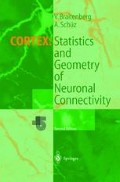Abstract
The system of cortical pyramidal cells, fairly uniform in shape (and presumably in their functional characteristics), interconnected by a very large number of excitatory synapses, invites speculations as to their mode of operation. We select three ideas which have been proposed: that of a global operation, that of Hebbian cell assemblies as carriers of meaning, and that of sequential order arising in Abelesian “synfire chains”. These ideas are by no means mutually exclusive and may well represent three aspects of a reality too complex to be grasped in its entirety.
Access this chapter
Tax calculation will be finalised at checkout
Purchases are for personal use only
Preview
Unable to display preview. Download preview PDF.
Author information
Authors and Affiliations
Rights and permissions
Copyright information
© 1998 Springer-Verlag Berlin Heidelberg
About this chapter
Cite this chapter
Braitenberg, V., Schüz, A. (1998). Global Activity, Cell Assemblies and Synfire Chains. In: Cortex: Statistics and Geometry of Neuronal Connectivity. Springer, Berlin, Heidelberg. https://doi.org/10.1007/978-3-662-03733-1_35
Download citation
DOI: https://doi.org/10.1007/978-3-662-03733-1_35
Publisher Name: Springer, Berlin, Heidelberg
Print ISBN: 978-3-662-03735-5
Online ISBN: 978-3-662-03733-1
eBook Packages: Springer Book Archive

